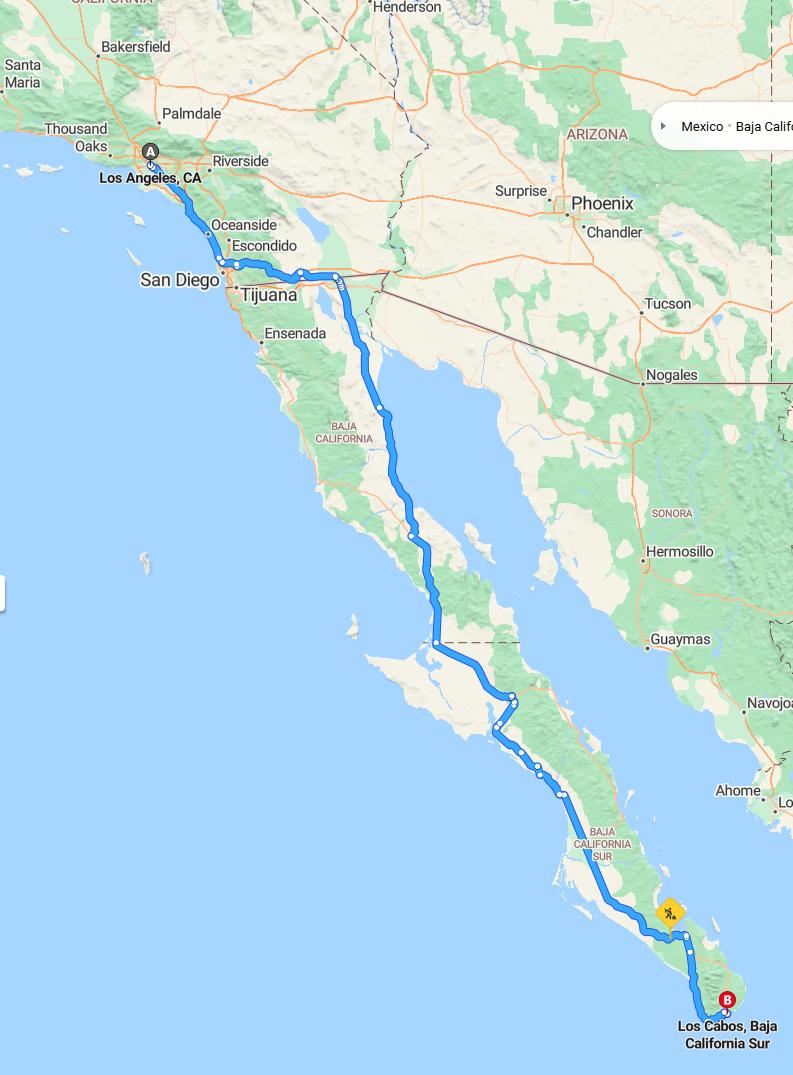Distance and estimated driving time
The drive from Los Angeles to Los Cabos covers approximately 1,136 miles via the MEX-5 and MEX-1 routes, offering a scenic and diverse journey. The estimated travel time is about 20 hours and 9 minutes, making it a lengthy but rewarding trip for adventure enthusiasts. Travelers should plan for rest stops and potential delays along the way to ensure a safe and enjoyable experience. This route provides an excellent opportunity to explore both the United States and Mexico landscapes while connecting two vibrant destinations.
Driving route
Traveling from Los Angeles to Los Cabos offers a scenic journey through diverse cities and regions. The route begins in Los Angeles, California, and passes through Riverside, Oceanside, and Escondido, providing a mix of urban and coastal views. Crossing the US-Mexico border, travelers enter Tijuana and then explore the vibrant city of Ensenada in Baja California. Continuing south, the route traverses the Baja California Sur peninsula before reaching the final destination, Los Cabos, known for its stunning beaches and resort towns. This drive combines cultural experiences, picturesque landscapes, and the excitement of crossing international borders.

Best time to start the journey
The best time to start your journey from Los Angeles to Los Cabos is during the spring or fall months, specifically from March to May or September to November, when the weather is typically warm and pleasant. Traveling during these seasons helps you avoid the peak summer crowds and extreme heat, ensuring a more comfortable drive. Additionally, starting early in the day allows you to enjoy the scenic route through Riverside, Oceanside, and Tijuana without feeling rushed. Planning your departure with weather conditions and local events in mind will make your trip more enjoyable and stress-free.
Road conditions and safety tips
The drive from Los Angeles to Los Cabos spans diverse terrains and road conditions, requiring drivers to remain alert and prepared. Major highways are generally well-maintained, but travelers should watch for sudden changes in weather or roadwork, especially in mountainous and border areas like Tijuana and Ensenada. To ensure safety, it is advisable to keep the vehicle in good condition, carry necessary documents, and stay updated on local traffic laws. Additionally, exercising caution near border crossings and rural regions can help prevent accidents and ensure a smooth, enjoyable journey.
Border crossing procedures at the Mexico-US border
When crossing the Mexico-US border from Los Angeles to Los Cabos, travelers should be prepared for specific procedures. At the border, vehicle and passenger inspections are conducted, requiring valid passports or acceptable travel documents. Customs agents may ask about the purpose of the visit, and travelers must declare any goods as necessary. It's important to follow all signage and instructions to ensure a smooth crossing, minimizing delays, and complying with border regulations.
Recommended stops and sightseeing landmarks
Traveling from Los Angeles to Los Cabos offers a variety of recommended stops and sightseeing landmarks. You can explore Riverside's vibrant cultural scene and charming historic districts, while Oceanside invites you to enjoy its beautiful beaches and seaside promenade. Tijuana provides an opportunity to experience lively markets and the famous Avenida Revolucion, before heading into Ensenada, renowned for its scenic coastal views and seafood cuisine. Continuing through Baja California Sur, travelers can visit natural attractions such as the Valle de la Luna and enjoy the stunning landscapes of Los Cabos, making the journey both scenic and culturally enriching.
Vehicle requirements and documentation for crossing into Mexico
Travelers driving from Los Angeles to Los Cabos should ensure their vehicle complies with Mexican regulations, including having valid registration and insurance recognized in Mexico. It is essential to carry a valid driver's license, along with additional documentation such as a tourist permit (FMM) if staying beyond a set period. Mexican auto insurance is mandatory, as Mexican authorities do not accept U.S. coverage; travelers should obtain insurance before crossing the border. Additionally, a temporary vehicle import permit may be required for certain vehicle types, and all documentation should be kept accessible during the trip to facilitate border crossing procedures.
Accommodation options along the route
Travelers driving from Los Angeles to Los Cabos can find a variety of accommodation options along the route to suit different preferences and budgets. In Riverside and Oceanside, there are numerous hotels, motels, and inns offering comfortable stays for travelers seeking convenience and affordability. As the journey progresses through Tijuana and Ensenada, visitors can choose from boutique hotels, bed and breakfasts, and resorts that provide a more local and cultural experience. In Baja California Sur and Los Cabos, a range of luxury resorts, beachfront hotels, and vacation rentals are available, allowing travelers to relax and enjoy the stunning coastal landscapes of Mexico.
Local traffic laws and driving customs in Mexico
When driving in Mexico, it is important to familiarize oneself with local traffic laws and customs to ensure safety and compliance. Speed limits are generally posted in kilometers per hour and should be strictly followed, especially in border areas like Tijuana and Ensenada. Using seat belts is mandatory for all passengers, and driving under the influence of alcohol is strictly prohibited, with severe penalties for violations. Additionally, drivers should be attentive to common driving customs such as honking to signal presence and yielding to pedestrians at crosswalks, which can differ from those in Los Angeles or Riverside.
Tips for fuel efficiency and emergency preparedness
When embarking on a long road trip from Los Angeles to Los Cabos, it's essential to prioritize fuel efficiency by maintaining steady speeds, reducing idling, and ensuring your tires are properly inflated. Planning your route to include major cities like Riverside, Oceanside, and Tijuana can help you find reliable gas stations along the way. Additionally, preparing for emergencies by carrying a first aid kit, spare tire, and basic tools can ensure safety during unforeseen situations. Staying informed about local conditions and having a mobile charger and GPS device can further enhance your travel experience and preparedness.
